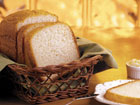
Many individuals afflicted with CD rely on blends containing rice flour, bean flour and sorghum as replacements for gluten-containing grains. These blends often produce inferior products (i.e., gritty, dry or crumbly textures); however, Expandex™, a modified tapioca starch made from tapioca root, emulates many properties associated with wheat-based ingredients such as texture and appearance. In addition, this particular modified tapioca starch can enhance the flavor of baked goods, creates a moist and expanded crumb, has excellent water binding and freeze/thaw properties, has a clean flavor and extends shelflife. For instance, when Expandex is used in a bread dough, its crust is crispy right out of the bread machine, in comparison to other gluten-free products that come out soft and very dry.
In a seven-day shelflife study conducted by Corn Products International, gluten-free bread was evaluated against wheat bread after being held under room temperature, frozen and refrigerated conditions. The bread was then evaluated at room temperature and after microwaving and toasting. “The gluten-free bread had a sweet flavor that was unaffected by storage or reheating, had an enhanced flavor and improved moistness when microwaved, and showed improved crispness and chewiness when toasted,” says Eric Shinsato, technical sales support manager for the company.
Product developers have created formulations containing gluten-free modified tapioca starch for bread, pizza crust and cookies and continue their work on other applications, as each one reacts differently under various conditions. In pizza dough, for example, the amount of liquid added is essential to developing a dough that can be rolled out without excessive stickiness. A wide variety of products can be made gluten-free including frozen entrées, chips, pretzels and other snacks, baking mixes and flours, energy bars, cookies, brownies, muffins and other baked goods, shelf-stable pastas, tortillas, breads and crackers.
For more information:
Corn Products International Inc., Westchester, Ill.
Jennifer Ohlinger • Jennifer.ohlinger@cornproducts.com
www.cornproductsus.com
Gluten-free Bread Starter Recipe
Yeast MixtureWater (appr. 105°-115°F) 10.00%
Sugar 4.00%
Yeast 0.55%
Wet Ingredients
Water (appr. 105°-115°F) 14.00%
Egg whites 10.80%
Vegetable oil 5.00%
Apple cider vinegar 0.30%
Dry Ingredients
Expandex™ modified tapioca starch 160901 31.50%
Rice flour 20.10%
Low-fat soy flour 2.00%
Salt 1.00%
Xanthan gum1 0.75%
1. Prepare the yeast mixture by dissolving the sugar in water, then sprinkling the yeast on top of the water -- set aside in a warm place for at least 10 minutes;
2. Weigh and blend all dry ingredients;
3. Add all of the wet ingredients except water to the dry ingredients and mix gently by hand;
4. Add the yeast mixture and mix for 1 minute (a mixer with a flat beater on a low setting is recommended);
5. Continue mixing and add remaining water until batter is well blended;
6. Place batter in a lightly greased loaf pan -- cover and proof for 1 hour;
7. Bake at 400°F for 25 to 30 minutes or until done.
This recipe also may be prepared in a standard bread machine.
1 Xanthan gum levels may be reduced or eliminated.
Source: www.expandexglutenfree.com (visit site for more recipes).